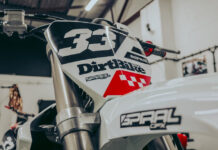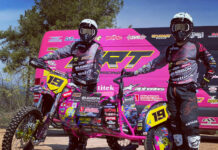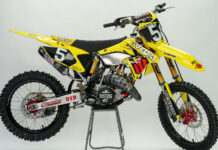Gas Gas are stepping things up again this year and are offering a range of bikes to get every off-roader just a little bit moist. First up you’ve got the ECF250 four-stroke that comes with a DEP tail pipe as used in our test. Then there are three different two-stroke ranges – Standard, Six Days and Racing – each with a choice of 125, 200, 250 and 300cc machines. And if that ain’t enough all models also come in both ‘EC’ and ‘CC’ trim…
The EC models come as fully homologated bikes whereas the CC models come as non-homologated units. They retain the front headlight and sidestand but lose the tail light, speedo, homologation parts and the ‘certificate of conformity’. The good news for us in the UK is the fact that the CC models can still be road registered and they retail for approximately £345 less than the EC models. Good times.
Yip, those smart senors at Gas Gas are going for it in big style by offering you, the consumer, pretty much everything you could ask for in an off-road bike. Good work el Gas Gas geezers!
And another added bonus is that as part of the Gas Gas UK team you, as a customer, are always only a phone call or email away from the latest set-up tips and information from Captain John Shirt Jnr and his technical team to keep your new Gasser gassin’.
Stepping up to the plate with the ECF250 four-stroke is a good move for Gas Gas and the engine they have chosen is a proven and amazingly reliable lump as used in the WR250. Gas Gas wanted to have solid performance and with this motor they have certainly chosen one of the best electric-booted motors possible to slot into their chassis. I personally think the bike looks absolutely superb with the new one-piece, slimline rear plastic section and black colour scheme. The bike flows in its design and ergonomics giving it a look of meaning business.
The fact that the bike is available with the stock and ‘race’ pipe here in the UK shows that the ongoing search for performance for the customer is working. The Sachs shock coupled to the Marzocchi forks is a tried and tested combination and I was looking forward to seeing if the new settings would work with the four-stroke motor producing the torque and ponies through the previously two-stroke-only chassis.
The two-stroke range continues to be refined for 2010 with improvements aimed at making the bikes even more user-friendly as the suspension finally takes responsibility and aims to deliver a vastly improved and balanced chassis. The unbalanced feeling from the chassis has pretty much been the only negative for me with the Gassers as in the past I’ve never jumped on the bikes and immediately felt comfortable enough to enjoy the early part of the ride.
So I was looking forward to being let loose on the bikes to see how they have improved this feeling to match up to the incredible motors which have been made to find traction. I simply wanted to find out if, finally, the collar would match the cuffs with the two-stroke Gasser range!
On the day we had the 200, 250 and 300 two-strokes and the all-new 250 four-stroke to test at an amazing secret test venue, deep in the pretty frikkin’ freezing Pennines. It was on!
The 200 is always a blast and the test model was fitted with an FMF tail pipe which is used on the Six Days model. The lightness and flickability of the 200 makes it a joy to ride and I knew the day was going to go well as within a minute the comfort levels on the bike were at a new level. The motor as expected pulled strong and the torque produced from the motor makes it workable in the most slippery of conditions. It was hard to get the exact feel for the overall set-up of the 200 as the lightness makes these bikes work great. It would only become apparent if the new, more user-friendly Gas Gas mentality would work on the larger capacity bikes as they pump out the big numbers of torque and BHP.
The 250 brings a smile as the motor gives an impression of having more cubes than its quarter-litre status would suggest. The amount of torque produced makes instant traction easy to find and a feather light clutch action makes using the power to its optimum a pleasure. What also helps make use of every bit of power is the new-found balance and subtle feel to the entire bike. Everything just seems to work better when the bike inspires confidence and the new, massively more user-friendly feeling which feeds up through the entire bike gives you a boost to go and tackle the challenges met in the great outdoors. The bike is not soft to the point of not getting any feedback as there is enough of a balance from compression, rebound and preload to keep a good level of ‘flickability’ to move the bike around with ease.
Big human, big power. I am a fan of a 300cc motor – the torque, the overall feeling of grunt on the edge of getting buck wild if required gets my attention every time and the Gasser delivers all of this with a smooth style. To say the 300 is solid would be an understatement as this is a very mature package with top level racing development. The ergonomics are quite racy as you sit ‘on’ this bike rather than ‘in’ it and the handlebar bend and height are comfortable for me at over six foot. This bike is built for comfort and speed which makes for a top rating in the DBR book of fine rides! The roll-on power delivery makes the 300 almost ‘four-stroke’ useable as it has an amazing amount of super low-down, smooth grunt – perfect for gaining that extra couple of feet up a technical climb or step without breaking traction.
As fun and fulfilling as the three two-smokers were it was the ECF250FT I really wanted to get my big Oirish mitts on. The 250F class of bike is a massive favourite among trail riders and racers – a competitive market of competitive yet easy-to-ride bikes with a friendly feel.
When I first sat on the little thumper – as with all the other 2010 Gassers – the ergos were all there in place. Handlebar to seat to peg all felt good and the controls all felt solid and ready for action. The bike sat quite low into its suspension stroke with my weight upon it but that’s expected with such a user-friendly machine. The digital speedo and timing display is easy to read and set up and the light switch cluster does the business. The on/off switch is located next to the throttle and just above the magic ‘e’ start button.
The bike breezed into life and the lack of vibration was immediately evident. The motor is solid and the engineers have done a good job of working the chassis around it. I was afraid of a weighty feel to the front of the bike due to the heavier engine but as I spent more time on the bike it was easy to work out the feeling and feedback the bike was giving me.
The motor on the test bike got better as the test wore on and it will continue to get better as these engines take some time to run in and reach their true potential. The engine braking is too much during this period and if the bike is being ridden in a bit of a slow motion style it would feel a little strangled. The racing tail pipe was fitted to the test bike and this made the power increase and allowed the bike to accelerate from zero up through the mid-range to give the bike a shot at lifting itself through some technical steps and sections.
The factory have made the forks hard enough to cope with the slightly different forces which come with a four-stroke motor without going too far and the rear shock follows along and keeps the bike stable and solid through the terrain. There was a great section with loose rocks all over the place (check the video on www.dirtbikerider.com) and these could be hit absolutely flat-out both up and down the hill section on the little thumper without any fear of it doing anything out of the ordinary.
It took confidence in the bike to hit that kind of terrain tapped so it’s a thumbs up from Wakka when it comes to the ECF 250…
Specification:
EC200
Capacity: 199.4cc
Bore and stroke: 62.5mm x 65mm
Transmission: Six-speed
Front suspension: Marzocchi 45mm (295mm travel)
Rear suspension: Sachs (310mm travel)
Front brake: 260mm disc
Rear brake: 220mm disc
Wheelbase: 1475mm
Seat height: 940mm
Kerb weight: 95kg
EC250
Capacity: 249.3cc
Bore and stroke: 66.4mm x 72mm
Transmission: Six-speed
Front suspension: Sachs 48mm (295mm travel)
Rear suspension: Sachs (310mm travel)
Front brake: 260mm disc
Rear brake: 220mm disc
Wheelbase: 1475mm
Seat height: 940mm
Kerb weight: 101kg
EC300
Capacity: 299.3cc
Bore and stroke: 72.5mm x 72.5mm
Transmission: Six-speed
Front suspension: Sachs 48mm (295mm travel)
Rear suspension: Sachs (310mm travel)
Front brake: 260mm disc
Rear brake: 220mm disc
Wheelbase: 1475mm
Seat height: 940mm
Kerb weight: 102kg
ECF250
Capacity: 249.6cc
Bore and stroke: 77mm x 53.6mm
Transmission: Six-speed
Front suspension: Marzocchi 45mm (295mm travel)
Rear suspension: Sachs (310mm travel)
Front brake: 260mm disc
Rear brake: 220mm disc
Wheelbase: 1475mm
Seat height: 940mm
Kerb weight: 110kg









